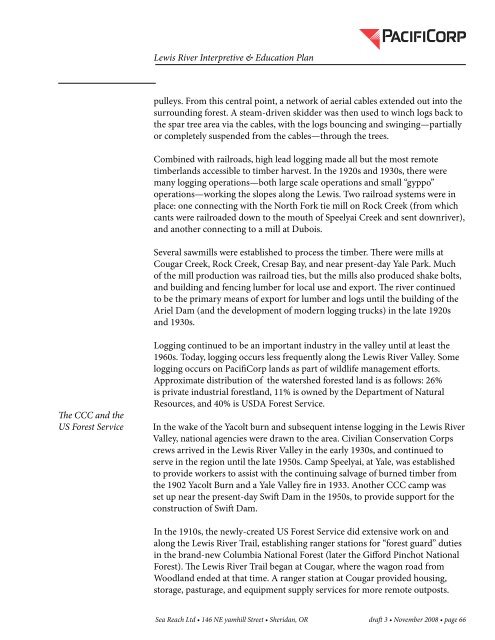The Lewis River Hydroelectric Projects - PacifiCorp
The Lewis River Hydroelectric Projects - PacifiCorp
The Lewis River Hydroelectric Projects - PacifiCorp
You also want an ePaper? Increase the reach of your titles
YUMPU automatically turns print PDFs into web optimized ePapers that Google loves.
<strong>Lewis</strong> <strong>River</strong> Interpretive & Education Plan<br />
pulleys. From this central point, a network of aerial cables extended out into the<br />
surrounding forest. A steam-driven skidder was then used to winch logs back to<br />
the spar tree area via the cables, with the logs bouncing and swinging—partially<br />
or completely suspended from the cables—through the trees.<br />
Combined with railroads, high lead logging made all but the most remote<br />
timberlands accessible to timber harvest. In the 1920s and 1930s, there were<br />
many logging operations—both large scale operations and small “gyppo”<br />
operations—working the slopes along the <strong>Lewis</strong>. Two railroad systems were in<br />
place: one connecting with the North Fork tie mill on Rock Creek (from which<br />
cants were railroaded down to the mouth of Speelyai Creek and sent downriver),<br />
and another connecting to a mill at Dubois.<br />
Several sawmills were established to process the timber. <strong>The</strong>re were mills at<br />
Cougar Creek, Rock Creek, Cresap Bay, and near present-day Yale Park. Much<br />
of the mill production was railroad ties, but the mills also produced shake bolts,<br />
and building and fencing lumber for local use and export. <strong>The</strong> river continued<br />
to be the primary means of export for lumber and logs until the building of the<br />
Ariel Dam (and the development of modern logging trucks) in the late 1920s<br />
and 1930s.<br />
<strong>The</strong> CCC and the<br />
US Forest Service<br />
Logging continued to be an important industry in the valley until at least the<br />
1960s. Today, logging occurs less frequently along the <strong>Lewis</strong> <strong>River</strong> Valley. Some<br />
logging occurs on <strong>PacifiCorp</strong> lands as part of wildlife management efforts.<br />
Approximate distribution of the watershed forested land is as follows: 26%<br />
is private industrial forestland, 11% is owned by the Department of Natural<br />
Resources, and 40% is USDA Forest Service.<br />
In the wake of the Yacolt burn and subsequent intense logging in the <strong>Lewis</strong> <strong>River</strong><br />
Valley, national agencies were drawn to the area. Civilian Conservation Corps<br />
crews arrived in the <strong>Lewis</strong> <strong>River</strong> Valley in the early 1930s, and continued to<br />
serve in the region until the late 1950s. Camp Speelyai, at Yale, was established<br />
to provide workers to assist with the continuing salvage of burned timber from<br />
the 1902 Yacolt Burn and a Yale Valley fire in 1933. Another CCC camp was<br />
set up near the present-day Swift Dam in the 1950s, to provide support for the<br />
construction of Swift Dam.<br />
In the 1910s, the newly-created US Forest Service did extensive work on and<br />
along the <strong>Lewis</strong> <strong>River</strong> Trail, establishing ranger stations for “forest guard” duties<br />
in the brand-new Columbia National Forest (later the Gifford Pinchot National<br />
Forest). <strong>The</strong> <strong>Lewis</strong> <strong>River</strong> Trail began at Cougar, where the wagon road from<br />
Woodland ended at that time. A ranger station at Cougar provided housing,<br />
storage, pasturage, and equipment supply services for more remote outposts.<br />
Sea Reach Ltd • 146 NE yamhill Street • Sheridan, OR draft 3 • November 2008 • page 66
















